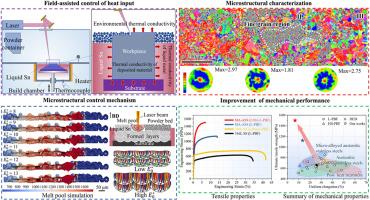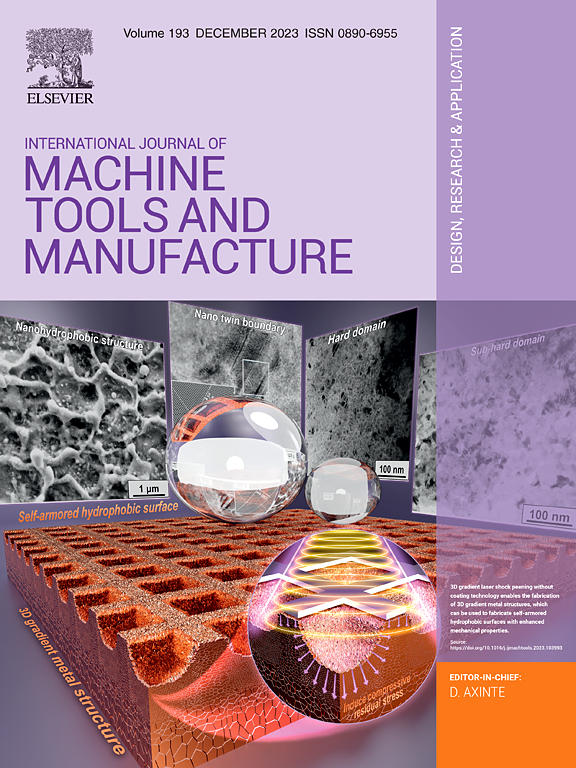A novel in-situ field-assisted powder bed laser fusion using liquid metal enabling microstructure control and strength enhancement of austenitic steel
IF 18.8
1区 工程技术
Q1 ENGINEERING, MANUFACTURING
International Journal of Machine Tools & Manufacture
Pub Date : 2025-09-06
DOI:10.1016/j.ijmachtools.2025.104334
引用次数: 0
Abstract
The layer-by-layer powder bed additive manufacturing approach, which encapsulates the workpiece in powder during processing, imposes limitations on the integration of in-situ field assistance and enhances production costs. In this work, a novel laser powder bed fusion has been proposed in which the layer-wise accumulated powder bed is replaced by a thin powder layer floating on the liquid Sn. Such a liquid-metal-assisted laser powder bed fusion presents unique advantages: the characteristic thermal history of deposited materials due to high thermal conductivity and fluidity of liquid metals provides greater possibilities for microstructure modulation; the recyclable liquid metal also reduces the need for powder in the forming cylinder and reduces the number of times the powder is reused. Based on the normalized process diagram of liquid-metal-assisted laser powder bed fusion, forming experiments were carried out on the austenitic stainless steels, and the mechanisms underlying the regulation of fine-grain regions were investigated, along with an analysis of the microstructure of this region. Results indicated that the high cooling rate during liquid-metal-assisted laser powder bed fusion led to a finer microstructure and a heterogeneous grain structure ranging from submicron to micron scales in the austenitic stainless steels. The formed heterogeneous austenitic steel exhibits a yield strength surpassing 1.1 GPa and a tensile strength of 1.5 GPa, while retaining an average uniform elongation of 7 %. The in-situ heat treatment principles using liquid metal demonstrated in this work have significant applicability across various additive manufacturing processes and precipitation-hardening alloys.

一种利用液态金属的原位场辅助粉末床激光熔合,可控制奥氏体钢的显微组织并提高其强度
逐层粉末床增材制造方法在加工过程中将工件封装在粉末中,这限制了现场辅助的集成,并提高了生产成本。本文提出了一种新型的激光粉末床熔合方法,即用悬浮在液态锡上的薄粉末层代替分层堆积的粉末床。这种液体金属辅助激光粉末床熔融具有独特的优势:由于液态金属的高导热性和流动性,沉积材料的特征热历史为微观结构调制提供了更大的可能性;可回收的液态金属还减少了成形气缸对粉末的需求,减少了粉末的重复使用次数。基于液体金属辅助激光粉末床熔合的归一化工艺图,对奥氏体不锈钢进行了成形实验,探讨了细晶区调控的机理,并对该区域的显微组织进行了分析。结果表明,液体金属辅助激光粉末床熔合过程中,高冷却速率使奥氏体不锈钢的显微组织更细,晶粒结构在亚微米到微米之间。形成的非均相奥氏体钢屈服强度超过1.1 GPa,抗拉强度达到1.5 GPa,同时保持7%的平均均匀伸长率。在这项工作中证明的使用液态金属的原位热处理原理在各种增材制造工艺和沉淀硬化合金中具有重要的适用性。
本文章由计算机程序翻译,如有差异,请以英文原文为准。
求助全文
约1分钟内获得全文
求助全文
来源期刊
CiteScore
25.70
自引率
10.00%
发文量
66
审稿时长
18 days
期刊介绍:
The International Journal of Machine Tools and Manufacture is dedicated to advancing scientific comprehension of the fundamental mechanics involved in processes and machines utilized in the manufacturing of engineering components. While the primary focus is on metals, the journal also explores applications in composites, ceramics, and other structural or functional materials. The coverage includes a diverse range of topics:
- Essential mechanics of processes involving material removal, accretion, and deformation, encompassing solid, semi-solid, or particulate forms.
- Significant scientific advancements in existing or new processes and machines.
- In-depth characterization of workpiece materials (structure/surfaces) through advanced techniques (e.g., SEM, EDS, TEM, EBSD, AES, Raman spectroscopy) to unveil new phenomenological aspects governing manufacturing processes.
- Tool design, utilization, and comprehensive studies of failure mechanisms.
- Innovative concepts of machine tools, fixtures, and tool holders supported by modeling and demonstrations relevant to manufacturing processes within the journal's scope.
- Novel scientific contributions exploring interactions between the machine tool, control system, software design, and processes.
- Studies elucidating specific mechanisms governing niche processes (e.g., ultra-high precision, nano/atomic level manufacturing with either mechanical or non-mechanical "tools").
- Innovative approaches, underpinned by thorough scientific analysis, addressing emerging or breakthrough processes (e.g., bio-inspired manufacturing) and/or applications (e.g., ultra-high precision optics).

 求助内容:
求助内容: 应助结果提醒方式:
应助结果提醒方式:


